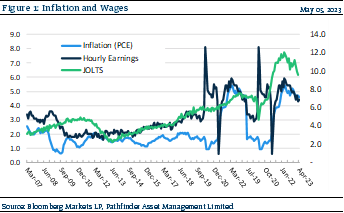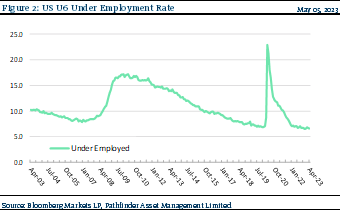Thoughts on the Job Market
Last week, we identified three areas of focus that we will be discussing over the rest of the spring. The interplay between these three major economic forces will impact all investors. They are somewhat related, and dependent on each other, so our discussion will sometimes seem circular, in that one topic leads to another. Three topics are:
- The trajectory of the economy and the potential for a slow-down / recession
- The Job market, its impact on corporate profitability (negative) and consumer spending (positive)
- Inflation and how the US Fed and financial markets interpret and react to data.
With respect to Item 2, there was some important data released today for the US job market. Job creation remains strong. Figure 1 presents some of the data released today along with data released over the past 2 weeks. The blue lines represent inflation pressure. Light blue is PCE inflation, which is the FOMCs preferred measure of inflation, and the dark blue line is today’s data for hourly earnings. You can see how closely they have moved together over the past year (i.e. wage inflation is correlated with overall inflation). The green line presents overall US job openings. As you can see, it has dropped after peaking, but remains high from a historical perspective (i.e. lots of open jobs result in higher wages).

Figure 2 presents underemployment data; currently unemployed workers, plus those part-time who would like a full-time job, plus those marginally attached to the labour force. This measure remains at an all-time low. We thought this was interesting because it provides another example of just how strong the employment market is in the US.

This means that, on the one hand, it is hard to see the US going into recession with such a strong employment market. Essentially anyone who wants a job can have one. On the other hand, we can see that a job market that is too hot would rationally stoke inflation from significant wage growth. A recession will probably come from breaking structural inflation with higher rates, and that means essentially creating unemployment. So far, it is hard to see where this will come from.
National Instrument 31-103 requires registered firms to disclose information that a reasonable investor would expect to know, including any material conflicts with the firm or its representatives. Doug Johnson and/or Pathfinder Asset Management Limited are an insider of companies periodically mentioned in this report. Please visit www.paml.ca for full disclosures.
Changes in Leverage. We are increasing the asset ceiling to 2.0 times the market value of equity for Pathfinder International Fund and Pathfinder Real Fund to be consistent with Pathfinder Partners’ Fund and Pathfinder Resource Fund
*All returns are time weighted and net of investment management fees. Returns from the Pathfinder Partners’ Fund and Partners’ Real Return Plus Fund are presented based on the masters series of each fund. The Pathfinder Core: Equity Portfolio and The Pathfinder Core: High Income Portfolio are live accounts. These are actual accounts owned by the Pathfinder Chairman (Equity) and client (High Income) which contain no legacy positions, cash flows or other Pathfinder investment mandates or products. Monthly inception dates for each fund and portfolio are as follows: Pathfinder Core: Equity Portfolio (January 2011), Pathfinder Core: High Income Portfolio (October 2012) Partners’ Fund (April 2011), Partners’ Real Return Plus Fund (April, 2013), and Partners’ Core Plus Fund (November 2014).
Pathfinder Asset Management Limited (PAML) and its affiliates may collectively beneficially own in excess of 10% of one or more classes of the issued and outstanding equity securities mentioned in this newsletter. This publication is intended only to convey information. It is not to be construed as an investment guide or as an offer or solicitation of an offer to buy or sell any of the securities mentioned in it. The author has taken all usual and reasonable precautions to determine that the information contained in this publication has been obtained from sources believed to be reliable and that the procedures used to summarize and analyze such information are based on approved practices and principles in the investment industry. However, the market forces underlying investment value are subject to sudden and dramatic changes and data availability varies from one moment to the next. Consequently, neither the author nor PAML can make any warranty as to the accuracy or completeness of information, analysis or views contained in this publication or their usefulness or suitability in any particular circumstance. You should not undertake any investment or portfolio assessment or other transaction on the basis of this publication, but should first consult your portfolio manager, who can assess all relevant particulars of any proposed investment or transaction. PAML and the author accept no liability of any kind whatsoever or any damages or losses incurred by you as a result of reliance upon or use of this publication.